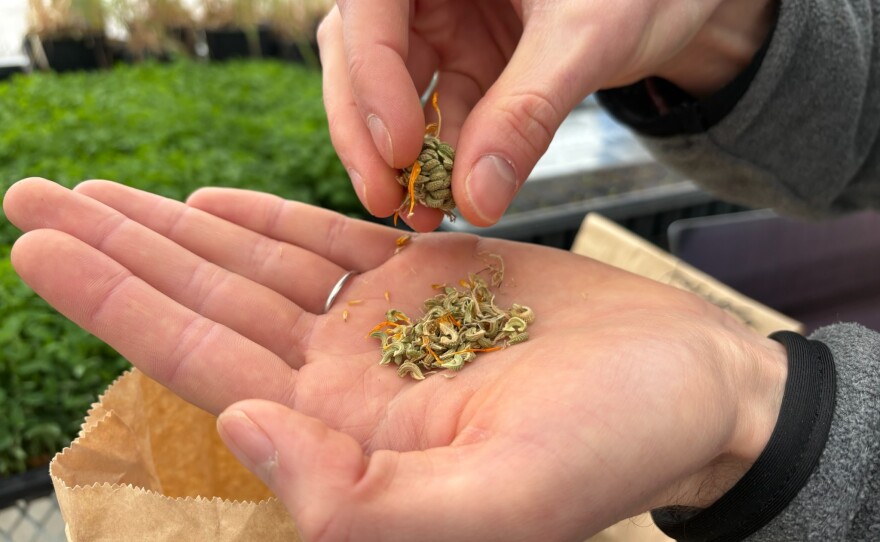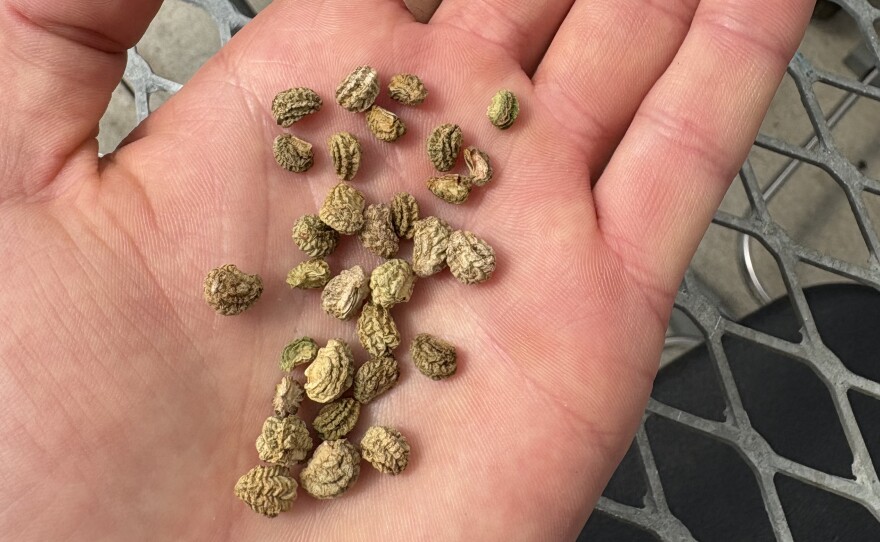Grow & Tell is a biweekly segment you’ll hear on IPR from now through the fall harvest.
Meet up with IPR
Explore native plants with IPR and Grand Traverse Regional Land Conservancy on Monday, April 28. Details here.
I'm Dylan Kulik, I manage an educational farm at Interlochen Center for the Arts, and I teach people how to grow their own food.
I'll take you step-by-step through gardening in your backyard or on your windowsill, with tips and plants suited for northern Michigan.
Today's tip: Companion plants
Companion plants are R.A.D., which is a little bit silly, but hopefully memorable: They repel, they attract and they distract.
Repel 👃🏼
Many companion plants are smelly — in a good way. This smell repels bugs or other creatures that don't like the strong scent of certain companion plants.
These plants work to deter pests from your garden.
Attract 🌸
Big, beautiful blossoms full of nectar attract insects and biological players you do want in your garden, like pollinators.
Attracting these bugs to your garden helps them do some work for you in a number of ways: good insects will pollinate your plants and help keep pest insects in check by eating them.
Distract 🚨
Distraction is my favorite benefit companion plants bring to the garden. Many pest insects fly around, smelling for tomatoes or other juicy plants they can attack. But if you cover up the smell of those crops with a strong-smelling companion plant, it's harder for pests to hunt your food.
Marigold, calendula, garlic chive and nasturtium
These are a few of my favorite companion plants that grow well in northwest Michigan. They each provide a mixture of repelling, attracting and distracting bugs.
Marigold
These bright yellow and orange flowers have a really strong citrusy, herbal smell that's repulsive to deer, rabbits and a myriad of pest insects like aphids.
I've grown these at the farm for several years, and I've been saving the seeds every year — I've only bought marigold seeds once. (In the fall, I'll show you how to dry these out and save the seeds for next year.)
My picks for marigold seeds: Durango outback mix, giant marigold mix
Calendula
Calendula is tied with marigold for the most beautiful blossoms that attract pollinators and other beneficial insects. Calendula seeds are also easy to save in the fall, like marigold.
Calendula adds a strong smell that deters pests, but you can also use this plant to make salves and balms, or for a colorful salad topping.
My pick for calendula seeds: Orange king mix
Garlic chive
Distract! Distract! Repel! Repel! Garlic chives, like other members of the allium (or onion) family, are famously smelly.
If you plant garlic chives right next to your tomato, for example, aphids might not be able to smell their way to their next meal as much as they would be otherwise.
Garlic chive is a perennial, so it can grow for a long time and it won't really mind being moved if you ever change your mind about where it's located in your garden. Plus, it's great for cooking.
Nasturtium
Nasturtium is another wonderful companion plant for repelling and attracting. They're also great if you're gardening with someone who has limited dexterity: the large, pea-like seeds are easy to handle.
I recommend you soak nasturtium seeds for 24 hours prior to sowing them because they're very absorbent and will suck up a lot of moisture — that pre-moistening will help increase germination success.
My picks for nasturtium seeds: Alaska mix, Empress of India mix
How to seed these plants and where to put them
Sowing
You can sow all of these plants inside for a head start. (Check out this Grow & Tell for how to do that.) I prefer starting them inside, because I know exactly how many plants I'll have when I want to transplant them into the garden. Starting these plants inside also gives you more reliable, consistent conditions. Do this no later than late April.
If you prefer, or if you're a bit behind, you can absolutely sow these seeds directly into the ground wherever you want to grow them. Don't sow them outside until after the last frost date has passed, typically late May. Just go outside, dig a shallow trough with plenty of access to water and sun, throw in your seeds, cover them with soil and wait.
Spacing
Put these plants right at the base of the main crop that you're growing. For tomatoes, I usually advise about four-foot spacing between tomato plants. So anywhere in between those two plants, you can put your marigolds, your calendula, your chives or your nasturtium, just make sure that they have enough sunlight and water.
I'd always recommend putting them on the south side of your main crop, whether it's tomatoes or bee balm, with about a one foot radius around them.
And remember, you can always move these companion plants whenever you need to. Start them at the base of your main crop and see how they play. If they end up being absolutely Herculean — perfect genetics and growing way larger than expected — scoop them up with a spade and move them somewhere else for more space.
At the end of the season, you can dry all of these plants and save their seeds for next year, closing the loop in your garden. In the fall, we'll talk about how to do that.
Another tool in the kit
You're not going to have a 100% success rate with these companion plants — some pests will still find their way into your garden. You'll also likely want to hang up sticky traps, spray your plants with a neem oil solution (an insecticidal oil) and pluck bugs off your plants (we'll talk more about pest management later in the summer).
What matters is that we're at least getting these companion plants' baseline benefits in our garden. We're using nature to do work for us in the garden.
Next time, we'll head outside to talk about how to pick the best spot for your crops, and what kind of diet you should feed them.
Until then, happy gardening!
If you have questions you want Grow & Tell to answer, email me at dylan.kulik@interlochen.org.
Trevor Reed composed Grow & Tell's theme music.















